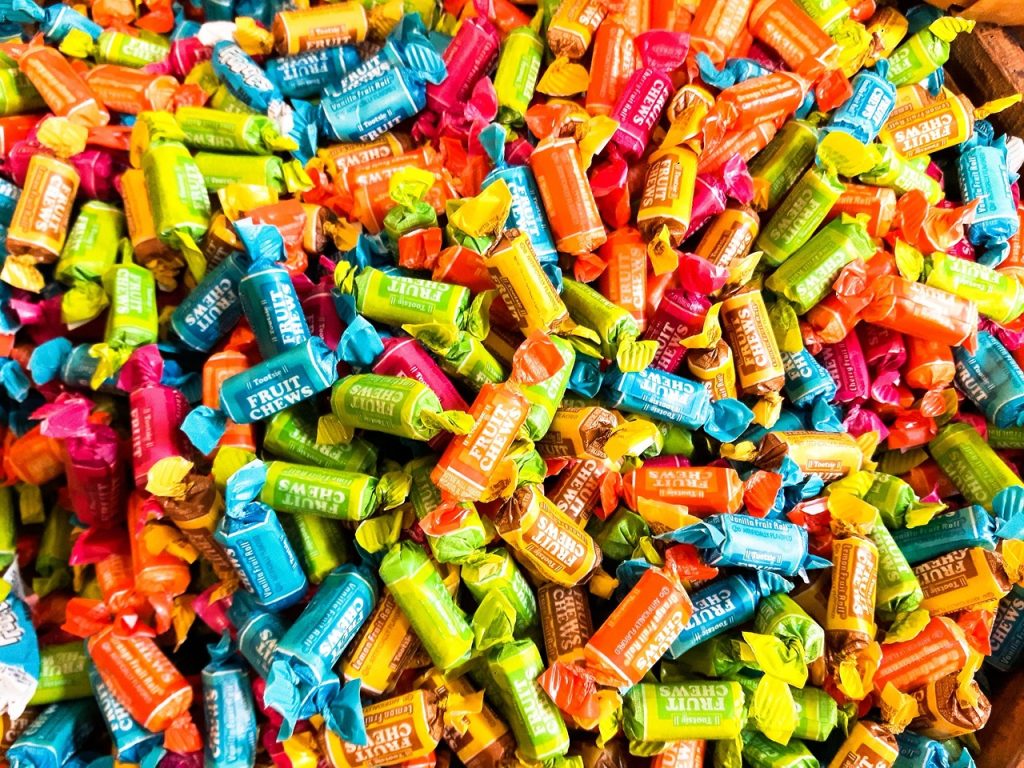With a record number of Trunk or Treats in our area, more to come and the Halloween candy bowls about to adorn every doorstep, it’s the perfect time for a “Trick or Treat” style reality check on some of the tricks (myths) and treats (truths) about the packaged sweets. Here’s a dive into the most common cliches about your fun-sized treats and if they pack more trick or treat!
Trick or Treat: “Food dyes are super dangerous, so you shouldn’t eat candy with them.”
The short answer: It’s mostly a trick, with a kernel of truth. Here’s why: Artificial food dyes like Red 40, Yellow 5 and Yellow 6 are widely used to make candy (and sodas, and bright cereals) more appealing. According to a review on healthline.com in 2023, regulatory agencies, like the US Food and Drug Administration (FDA) and the European Food Safety Authority (EFSA), “concluded that the dyes do not pose significant health risks.” However, in some cases, dyes have raised health concerns. For example, certain dyes were found to cause hypersensitivity or behavioral issues in children, and some animal studies even suggested potential carcinogenicity. However the National Institute of Health (NIH) (https://pubmed.ncbi.nlm.nih.gov/23026007/) says this doesn’t mean that your Halloween candy bowl is a toxic trap, it just means you may not be entirely off the hook. For most healthy adults and children the level of food dye in candy aren’t proven to cause harm, let along any major harm. But, if someone is dye-sensitive of even believes they may be sensitive, it may be worth checking ingredients. So: treating it like a mild “be aware,” not a hard limit.
Therefore, we give this one a: Trick
Trick or Treat: “Gelatin in candy comes from horse hooves.”
Short answer: Mostly a trick!
Yes, it’s true that many gummy candies, marshmallows, etc., contain gelatin, which is derived from animal collagen (skin, bones, hides) of pigs or cattle. But the NIH, who published their study on pubmed.ncbi.nlm.nih.gov, share that the part about hooves and horses? Not so much. According to fact-checkers, commercial gelatin does not generally from horse hooves. Yes, it’s animal-derived (unless the product specifically uses a vegetarian/vegan alternative) but not the myth that it’s from horse hooves is largely false, so this one gets knocked down.
Therefore, we give this one: Trick if you believe the “horse hooves” claim is accurate. Treat for if you believe “gelatin comes from animal collagen, so check your labels if that matters to you.”
Trick of treat: “Trans fats in candy will kill you; stay away from packaged treats.”
Short answer: Treat, aka true, but context matters. Here’s the deal: The term “trans fat” refers to trans-fatty acids, especially industrially produced ones (often via partially-hydrogenated oils) that are found in processed baked goods, fried foods, and some snack items. The World Health Organization (WHO) (https://www.who.int/news-room/fact-sheets/detail/trans-fat) shares that Trans Fats are very well documented to raise bad (LDL) cholesterol, lower good (HDL) cholesterol, and increase the risk of heart disease. What is the good news? In recent years, the U.S. (and many other countries) have taken action to ban or restrict these artificial trans fats. On Halloween, many candies are sugar-based, not high-trans-fat, so the risk may be much lower—but it’s still wise to check the label (look for “partially hydrogenated oils”) if this is a concern to you.
Our score: Treat for the “yes, trans fats are bad and should be limited.” But Trick if you believe only candy and treats carry the worst trans fats (many have been removed) or that every bite is a death sentence. Be more leery of snack cakes and other treat items with longer shelf lives.
Final pointers for your candy bowl health check and deciding if the quick fix is a trick or a treat:
- Moderation is key: enjoying candy is fine in the context of an overall diet as long as it’s in moderation and a limited amount.
- Look at ingredient labels if you or your children are sensitive to dyes or follow a vegetarian/vegan/halal/kosher diet (gelatin matters).
- Keep in mind the bigger picture: nutrient-rich foods matter more than obsessing over every bite of candy.
- Encourage fun alternatives: maybe include some darker chocolate, dried fruit, or low-added-trans-fat sweets along with the classic candy, and you’ll have less to worry about.
From all of us at The Wellness Center, we are wishing you a Happy and Healthy Halloween! May your candy haul be fun and filled with memories and time well spent this year. Before you offer too many suggestions to others or start to wonder if you can indulge just remember most of what you hear isn’t true! A mini treat won’t make or break you in moderation. Enjoy the season, have fun and happy Halloween.


